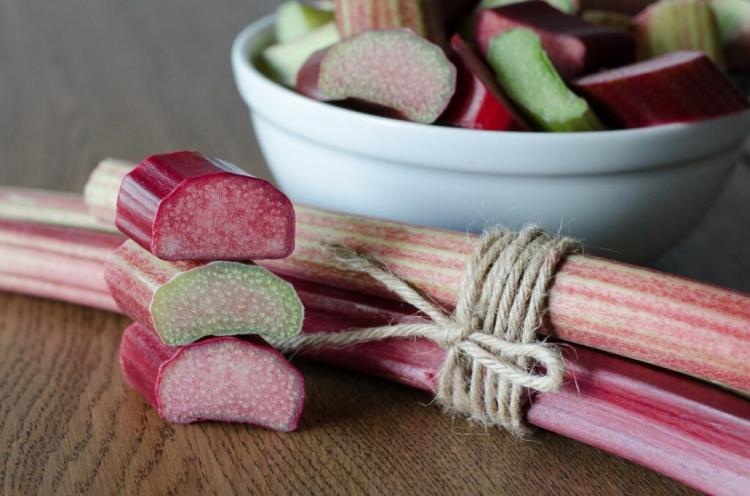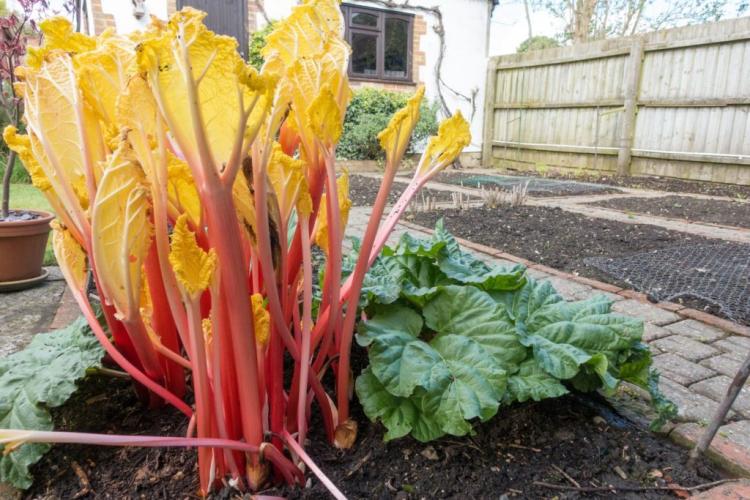Rhubarb: Planting, Fertilizing And Harvesting The Barbarian Root
Rhubarb takes up little space and is very popular with amateur gardeners. We show you how to properly plant, fertilize and harvest rhubarb.
The rhubarb (Rheum rhabarbarum ), one of the knotweed family, is one of the first vegetables of the year. Although rhubarb is popularly incorrectly referred to as a fruit, which can be attributed to its use in desserts, it is actually a leaf-stalk vegetable such as Swiss chard or celery. Due to the current return to old varieties and regional references, the rhubarb has experienced a real boom in recent years.
Rhubarb tastes delicious in many variations and can be grown wonderfully in your own garden. The perennial plant can be harvested again every year without much effort. Their strong fragrances also protect them from predators, which further facilitates successful cultivation. Since rhubarb is resistant to cold and frost, it is also ideal for cooler gardens. In the following, we will introduce you to everything from varieties of rhubarb to proper planting and care to harvesting.
Rhubarb: origin and history
Table of Contents
Rhubarb is native to the Himalayas and parts of China. The related plant species such as the Tibetan rhubarb ( Rheum Officinale ) and the palmate rhubarb ( R. palmatum ) were used as medicinal products in traditional medicine. It was not the stems that were processed, but mainly the underground sprouts. The vegetable rhubarb found its way via Central Asia to England, where it has been grown since the 18th century. Even today, the rhubarb is still very popular in England, which leads to names such as the Rhubarb Triangle, a rhubarb stronghold in West Yorkshire. The plant then reached Germany, Austria, and Switzerland via England.
Rhubarb varieties
The varieties of rhubarb are differentiated either according to the time of harvest (early, medium, and late-ripening varieties) or according to the color of the stems. In general, green varieties are more productive, but the red-fleshed varieties are assigned a milder taste and higher ornamental value. There is a tremendous variety of varieties to choose from. You can find an overview of the best known here:
- ‘Champagne’: early and high-yielding variety
- ‘Elmsblitz’: Old and dark red variety of rhubarb with a low oxalic acid content
- ‘Elmsjuwel’: stem and meat red with a low acid content; especially recommended for people sensitive to oxalic acid; medium yield
- ‘Frambozen Rood’: Late and aromatic variety with red stems and green flesh; Because of the scent, Frambozen Rood is also known as strawberry or raspberry rhubarb

- ‘Gigant’: Very vigorous and green-stemmed variety with a high content of oxalic acid
- ‘Goliath’: Largest red-stemmed and green-fleshed rhubarb variety with stems up to 100 cm; during flowering, the plant reaches up to 180 cm; high quality and very high yielding variety
- ‘Holsteiner Blut’: Very well-known variety in which the stems are red at the end; the variety is known for its mild taste and high sugar content
Plant rhubarb
The easy-care rhubarb is a disease-resistant and worthwhile plant that should not be missing in any garden. He likes it humid and prefers a rather harsh climate, as a sufficiently long cold period is a guarantee for a good yield. Rhubarb prefers a sunny, sheltered location in the garden. The soil should be permeable and ideally have a pH of 7. Since rhubarb reproduces a lot, you should calculate about one square meter of space per plant.
Root pieces of older plants or container plants that can be planted in April or autumn are planted either in autumn. As a temporary solution, rhubarb can also be cultivated in pots, but you should make sure that you have a sufficiently large planter and permeable soil.
Propagate rhubarb
You can propagate rhubarb either by dividing it or by sowing it. The division is a very simple form of reproduction. To do this, the rhubarb is first dug up. Then one carefully divides the rhizome with a digging fork or a spade into pieces (“lumps”) weighing approximately one kilogram. Make sure that each “lump” has at least one shoot tip. Chopping through roots is often essential for division. The separated pieces are then planted in nutrient-rich soil and watered well.

The second way to propagate rhubarb is to sow it from purchased seeds. Sow them in the cold frame in May. However, rhubarb propagated from seeds can vary greatly in taste and color, so “cloning” a rhubarb plant by dividing it is more suitable for your own propagation.
You might so like: Rhubarb Forcing And Bleaching: Instructions From The Expert
Caring for rhubarb
In itself, rhubarb is not particularly maintenance-intensive. Here we have summarized all the important information about caring for the plant for you.
Fertilize rhubarb
Rhubarb loves nutrient-rich, compost-enriched soil. It is sometimes difficult to add compost to the mature perennial, which is why it is important, especially when planting, to enrich the soil beforehand with sufficient compost or primarily organic slow-release fertilizer. Our Gardender organic tomato fertilizer is such a long-term fertilizer with a three-month effect and contains all the nutrients necessary for a rich rhubarb harvest. The best time for further fertilization is after the harvest in June or July. Learn how to fertilize rhubarb plants.
You might so like: 10 Tips For Growing Rhubarb
Pour the rhubarb
The only thing you should do when pouring the rhubarb is to be careful not to keep it too dry or too wet. Rhubarb does not tolerate waterlogging well. Some sources recommend removing the inflorescences, which can also be consumed. However, it is not necessary to remove the flowers.
Pests and diseases
In general, rhubarb is not very susceptible to disease. The location of the plant should be changed every 10 years. Here it is advisable to plant young plants or, if necessary, prick off young rhizomes of the mother plant. In very heavy and damp soils, there can sometimes be problems with rot. In general, in such a case, the soil should be well loosened with plenty of compost before planting. Scissors or knives should not be used when harvesting, as they can transmit diseases.
Harvest rhubarb
The rhubarb is generally only harvested in the second year after planting. The harvest time then begins in April and lasts until St. John’s Day (June 24th). After that, you shouldn’t harvest your rhubarb for two reasons: on the one hand, to allow the plant a rest and recovery phase and, on the other hand, because of the increase in the oxalic acid content. People suffering from iron deficiency and those with gout, rheumatoid arthritis, or kidney disease should generally be cautious about consuming foods containing oxalic acid such as rhubarb.

You don’t cut the rhubarb stalks but twist them carefully out of the ground. Otherwise, the plants can rot at the interfaces or develop other diseases. Approximately three stalks can be harvested from each fully grown plant per week without causing any lasting damage to the plant. Although the stems can be kept moist in the refrigerator for about a week, only the amount that is actually needed to protect the plant should always be freshly harvested. The leaves of the rhubarb can be removed directly during harvest, as they have a high content of oxalic acid. If the leaves are not removed, the rhubarb stalks lose water and quickly become limp.
Force rhubarb and bleach
So-called forcing and bleaching is one way of bringing the rhubarb harvest time up to three weeks forward. For this purpose, at the end of February, a vessel (English forcer) is usually placed over the rhubarb, which is still in the ground. The so-called jacking pot or bleaching pot is usually a slim terracotta vessel with a removable lid. Since the drifting pot catches the first rays of the sun of the year and stores the heat inside for a few hours after sunset, the rhubarb begins to drift early in the year. The darkness also speeds up the growth process as the plant shoots up in search of light. The gardener can check the growth progress through the removable lid.

Preserving rhubarb
The rhubarb sticks contain a lot of vitamin C and taste great in desserts, cakes, juices, and jams. If the rhubarb harvest turned out to be a bit too rich, there are ways to preserve it. We have gathered everything you need to know about freezing and boiling rhubarb so that you can enjoy your tasty rhubarb harvest for as long as possible.
Freeze the rhubarb
Thoroughly wash the sticks with water and peel the rhubarb. Then it is advisable to cut the sticks into smaller pieces and fill them in a suitable container for the freezer. So you can still enjoy your rhubarb harvest at any time. The frozen pieces are particularly suitable for later making into compote or cakes.
Reduce the rhubarb
If you cannot process your rhubarb in good time or want to preserve it for later enjoyment, you can also boil it down with compote or jam. To do this, wash and peel the rhubarb and cut it into slices about a centimeter wide. Before actually cooking the rhubarb should be placed in boiling water for about five minutes to reduce the content of oxalic acid.

Basically, rhubarb can be boiled down in two ways. Only in water or as a sweet alternative with sugar and without water. For both variants, you cook the rhubarb to the desired consistency, often ten minutes being enough. After cooking, it is filled into sterilized jars while still hot and these are tightly closed. Place the jars on the lids until they are completely cool. The cooked rhubarb can easily be kept for several months in a dark place.






